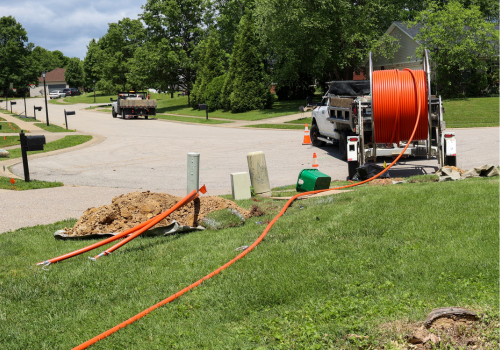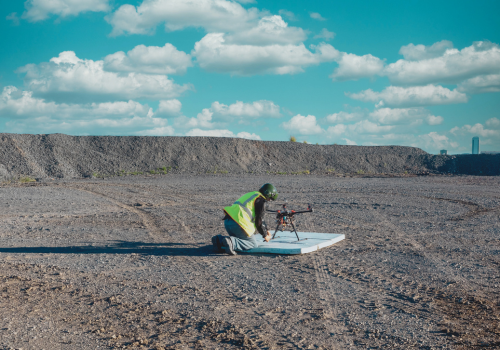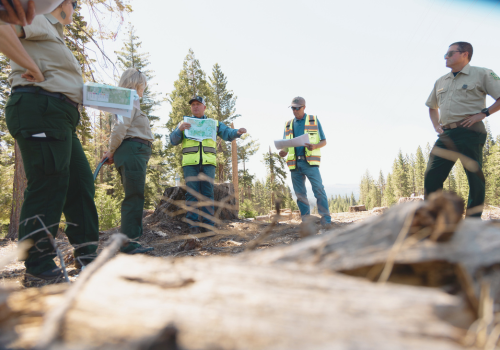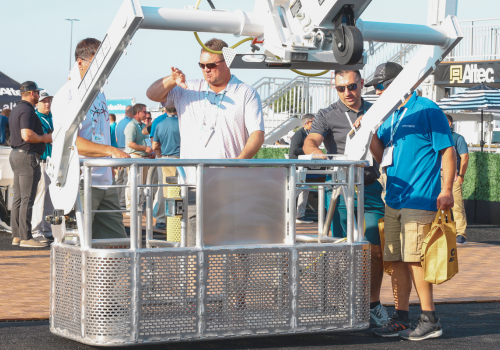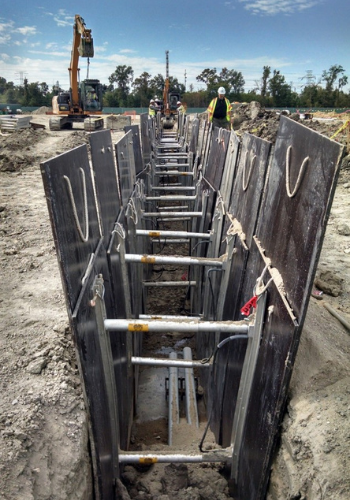 Here are some considerations to help you decide when trench shoring or shielding equipment is needed, how to weigh the costs between buying or renting and ensuring your employees are properly trained and supported.
Here are some considerations to help you decide when trench shoring or shielding equipment is needed, how to weigh the costs between buying or renting and ensuring your employees are properly trained and supported.
Excavation and trenching are some of the most dangerous jobs in utility work. According to the Occupational Safety and Health Administration (OSHA), cave-ins lead to hundreds of injuries and dozens of deaths each year. Yet these accidents are completely preventable. So it’s critical to know the regulations, guidelines and best practices for protecting workers.
First and foremost is recognizing the risks involved. Trenches can fail suddenly and without warning. Workers simply may not have enough time to get clear. In addition, a single cubic yard of soil can weigh as much as a car — more than enough to suffocate or cause serious injuries to anyone caught in a collapse.
“Almost every one of those fatalities occurs with no shoring in place,” says Steve Hanley, general manager for Cerda Industries. “We know soil will cave in. We just don’t know when. It’s Digging 101: Any time someone’s in the hole, they need to be safe.”
“Trench systems save lives,” says Dennis Parker, national account manager for Arcosa Shoring Products. “You need to make sure workers go home at the end of the day.”
When Trench Protection Is Needed
OSHA defines a trench as “a narrow underground excavation that is deeper than it is wide, and is no wider than 15 feet.” That, of course, covers a tremendous range of utility applications — including electrical distribution and transmission, telecommunications, gas/oil distribution, drinking water and wastewater.
“The OSHA standard requires trench protection for all excavations five feet or deeper, or whenever the competent person on site determines there is a danger,” says Hanley. For trenches 20 feet deep or greater, the protective system must be designed or approved by a registered professional engineer.
OSHA classifies trench protection systems into three main categories. Sloping involves cutting back the trench wall at an angle inclined away from the excavation. Shoring employs aluminum, hydraulic or other supports to brace or shore up the walls of a trench. Shielding uses steel or aluminum structures to protect or shield workers from a cave-in.
No matter how many trenching projects a utility contractor has successfully completed, each new job requires careful evaluation and preparation.
“Every project, every depth, every soil type brings up different considerations,” says Hanley. “If you’re placing a 12-foot-square precast concrete vault, you need a heavier protection system. Ground water adds loading and has to be taken into account ahead of time. You need to know the system will comply with OSHA requirements, that you’re qualified to handle it, and that you can do the job safely.”
“Soil types vary greatly, from real hard clay all the way to soft, sandy soil,” says Parker. “You have to do soil testing and make sure you know what you’re working with. It’s really about the dirt and the job you’re trying to do.”
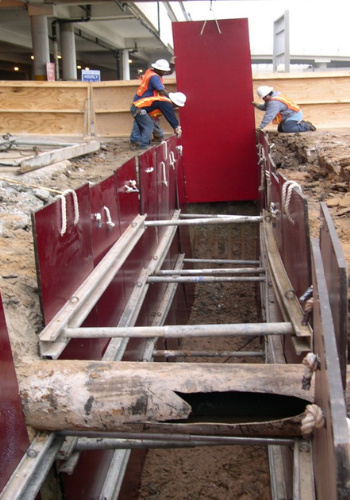 Deciding to Rent vs. Own
Deciding to Rent vs. Own
The decision to purchase or rent trench protection equipment is a business question. The answer to that question will vary from contractor to contractor.
“I’ve been on the rental side of trench protection,” says Hanley. “If you’re going to use this equipment for nine months a year, you need to own it. If it’s a three-week job, rent it; it makes no sense to invest. In between, whether you rent or own depends on your capitalization, depreciation, yard space and whether you’re going to maintain it.”
“Utility excavation is somewhat of a niche subcontract. Most companies own a large part of what they use and rent for the one-off projects. While everyone hates to write a check for a rental expense, there are jobs where it makes sense.”
“It’s an individual choice,” says Parker. “If you’re only doing one type of utility work, you might be able to buy equipment that covers 50 to 70 percent of your daily needs. But I’ve seen a shift to rental over the past 20 years. The variety of options available to contractors today makes renting trench protection equipment a very appealing option. You can just get what you need when you need it.”
Employee Training Is Key
Ultimately, trench safety comes down to giving employees the training, information and support they need.
“It’s impossible to protect utility workers without training,” says Hanley. “I’ve been in training classes where three-quarters of the people there say they’ve been in an unshored trench. Even if it’s only for a moment, that’s all it takes for a collapse. OSHA fines have increased, but that’s like a traffic ticket. An actual lawsuit coming out of a fatality is about $3.5 million. Your business may not survive that.”
“A lot of people don’t know the risks of working underground,” says Parker. “OSHA mandates that utilities train all employees about any hazards related to the job they’re doing. Training is valuable for the fact you want to make employees aware of the potential hazards they face and how to prevent them. A good safety program doesn’t cost much compared to the potential cost of not following one.”
Many utility contractors also count on third-party resources provided by equipment distributors and manufacturers — such as employee safety training, jobsite consultation and engineered designs.
“Foremen come and go. It helps to have an excavation specialist within the company, a go-to resource when there’s a question,” says Hanley. “The largest equipment distributors have established their own training programs as part of their marketing to customers. But smaller distributors don’t always have those resources. We will occasionally train customers at their request — explaining how shores work, when you can and can’t use them, alternatives where they would use a steel shield but want something lighter. Every product has its proper place.”
“You have to make a commitment to ensure your people are competent, that they’re protected, that they’re following guidelines and working safely,” says Parker. “With the right training and expertise in place, you can determine the right equipment for the right application.”
Brands Featured in this Article:
Trench Shoring & Shielding Association Resources:
- 8 Good Reasons Why Trench Shoring and Shielding Saves You Money
- Trench Shoring and Shielding Do's & Don'ts
- An Introduction To Modern Trench Shoring and Shielding
OSHA Resources:
Join thousands of industry peers who receive utility construction industry news and trends each week. Subscribe to The Utility Expo Newsletter.


